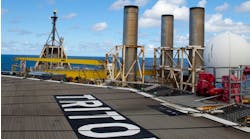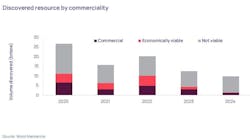By Jeremy Beckman
Editor, Europe
FPSO could later assume storage role
Onshore fields provide the bulk of Libya's oil and gas production, the sole exception being Agip's Bouri. The government, however, is keen to step up activity offshore, mindful of Egypt's drilling success in the Mediterranean.
C137-B location off the Libyan coast.
One project newly under way concerns an oilfield with associated gas in offshore block C137, known as the B structure. This will feature North Africa's second new floating production, storage, and offloading (FPSO) vessel this century, following Coparex's Isis off Tunisia.
Partners in the new development are TotalFinaElf with 37.5%, Germany's Wintershall with 12.5%, and Libyan National Oil Company (NOC) with the balance. TotalFinaElf affiliate Compagnie des Petroles Total Libya (CPTL) is operating the project, which is based in 83-87 m water depth, 100 km offshore western Libya. Estimated investment is just over $230 million, excluding the lease of the FPSO, although more will be allocated for future phases.
Exploration history
Elf Aquitaine Libya was the original concession holder for the acreage, signing a contract in 1974. Elf Aquitaine was registered in Libya and started its activity in the country in 1968. The original contract relating to Block C-137 was signed on Oct. 13, 1974, between the NOC, Elf Libye, and Aquitaine Libye, the operator. At this stage, no other parties were involved. In October 1975, Wintershall and OMV joined the association. Exploration started almost immediately, with seismic acquisition followed by a well on the B structure the same year, which yielded the B1 oil discovery. In 1983 a first appraisal well was drilled on the west flank, but this found water.
All initial work obligations were fulfilled by 1984, but progress slowed for several reasons. One was the questionable economics of the proposed development at that timee. Another was the United Nations' sanctions regime imposed on Libya following the Lockerbie incident. "Clearly, it was a bold move to renegotiate the contract at that time," says Jean-Marie Guillermou, Vice President of E&P in the (North African) Maghreb region for TotalFinaElf.
Erection at slipway, Izar Fene yard (March 2002).
New terms were, however, agreed in 1996 and ratified the following year, extending the exploration and production sharing contract for a further 24 years. At this time OMV assigned all of its interest to Wintershall. The B3 appraisal well was subsequently drilled on the B structure, and confirmed the discovery.
Reservoir analysis suggests that there are two productive formations. Of these, Al Guerria houses most of the discovered oil, with porosities of 20-25%, and average permeability of a few hundred millidarcies. Within the Chouabine formation, porosity is much lower, and also variable, with permeability of less than 0.10 millidarcy. The reservoir depth varies from 2,150 m to 2,160 m below the sea floor.
Steel blocks fabrication at Izar Fene.
The decision to move toward development was made during the merger of TotalFina and Elf in 1999-2000, and the final investment decision was approved by NOC in early January 2001. The project's operator, CPTL, is a non-profit organization, managed by a committee under NOC's control.
Awards procedure
The final production concept for 137-B was formulated by the TotalFinaElf engineering center in Pau, southwest France. This was followed by a call for tenders for four engineering, procurement, construction, and installation (EPCI) contracts.
When CPTL, which also operates the onshore Mabruk Field in the Sirte Basin for NOC and TotalFinaElf, was nominated as operator for the offshore field. It endorsed the calls for tender, which had already been issued. The next step was to award contracts for the platform, the FPSO, the drilling unit, and the sealines.
"It's a very basic development scenario," says Guillermou, "involving one normally unmanned, 16-slot wellhead platform sending crude for processing to an FPSO via a sealine. Early on, we considered a tanker conversion for the vessel, but then we decided that as this looked to be a long-term operation, it deserved a newbuilding."
The $54 million EPCI contract was awarded in March 2001 to a consortium led by Bouygues Offshore. The latter handles design of the platform and jacket engineering from its offices near Paris. Engineering of the deck, and construction of the entire platform (which began last September) is being performed under Bouygues Offshore's supervision by the Rosbos consortium at Rossetti Marino's yard in Ravenna, Italy.
According to Gerard Bonnet, Bouygues Offshore's Vice President for Marine Works Activities, the platform is a largely conventional design, with minimized equipment packages, and including first-stage separation. Its three-level deck will weigh 2,400 tons, and the jacket 5,500 tons. These will be transported to the field by Stolt Offshore, probably in October, and installed by the same contractor using driven piles. The jacket will be launched.
Lifting of side ballast tank, Izar Fene.
The compact drilling rig, awarded last year to Saipem, is currently under preparation in a yard in Sardinia and will be installed on the platform when the latter is completed.
In mid-2001, Antwerp-based Exmar Offshore was contracted to supply the FPSO on a leased basis to CPTL and to manage production operations. Exmar awarded construction of the 900,000-bbl vessel to Izar's Fene yard in northwest Spain, formerly known as Astano. Doris Engineering in Paris secured the $32 million EPCI order for the FPSO's topsides, turret, electrical subsea cable, and mooring system.
The outfitted FPSO will arrive on location off Libya a couple of months after the wellhead platform. In the intervening time, the drilling contractor, Saipem, should have recovered the B3 well, which will then be ready for a production start. A total of 10 wells will likely be drilled during the first phase of development. These will be drilled from the platform using a temporary, reconditioned compact rig (weighing 6,600 tons in service). Once in production, the wellstream will pass to the FPSO for processing through a 3-km-long flexible pipeline supplied and installed by Technip-Coflexip's CSO Alliance.
Newbuild decision
Izar has a solid track record in offshore hull construction and outfitting at Fene, located near Ferrol. Over the past decade, the yard has delivered FPSOs for the Gryphon, Foinaven, and Captain projects in the UK sector, the floating storage unit (FSU) for Chevron UK's Alba development, and three newbuild deepwater drillships for Transocean Sedco Forex. It has more experience than any other yard in Europe in adapting its construction schedules quickly, which is a pre-requisite for most fast-track FPSO projects.
As regards 137-B, Fene is responsible for the design, engineering, and construction of the hull, as well as the engineering interface with the turret and topsides modules, most of which are coming from France or the UK. It is also manufacturing certain equipment items for the engine room and deck, in association with other Izar yards in Spain.
According to Project Manager Jorge Lopez Novo, "We were first approached about this project in August 2000. At that time, Exmar was focusing on a conversion, at TotalFinaElf's request, although a newbuilding was also an option.
"In late September 2000, we were submitting our proposal for a newbuild FPSO, having put together a detailed basic design in just four weeks. In fact, the main parameters for the vessel have not changed much from that document. Afterward, a clarification process followed, mainly concerning the scope of work, as our estimate varied from what Exmar had in mind for a conversion."
The completed vessel will have a length of 210 m, a breadth of 44 m, a depth of 23 m, and a design draft of 16.5 m. When fully laden, it will have a deadweight of 147,700 tons. The vessel will be able to weathervane 360 degrees around its turret. The harsh local environment necessitates strengthening of certain support structures. To aid stability, 60-m-long bilge keels are being fitted along the vessel's sides. This arrangement has been successfully model tested at a basin in La Seyne-sur-Mer, near Toulon, in southern France. At the front of the vessel, a high bulwark will be installed to protect the deck from green water.
Doris Engineering's responsibilities include design and procurement of the main process equipment, the turret and its associated mooring system, connections for the electric cable between the FPSO and the platform (the latter will be controlled directly from the vessel), and the connections for the flexible hose offloading crude to visiting shuttle tankers.
"The turret is our design," says Doris Chairman Dominique Michel. "Our turret for this vessel will have a roller bearing at the top end on a cantilever structure, and a plain bearing at the lower end. This means you have two supports, which will, in turn, lessen the need for reinforcement of the hull." The two bearings are linked to a shaft, which is then connected to a chain table to which the mooring lines are connected.
"Conditions in this part of the Mediterranean are very rough, with a maximum wave height of 16 m, and a wave period of 12-15 seconds. This, combined with strong winds and currents, exerts large forces on the turret. As the water is not very deep, and the maximum offset for the risers is quite small, the mooring system is extensive," Michel said.
"The turret will be fixed on the vessel's bow. It will feature just one production swivel, for water and oil, and one electrical swivel. The design is deliberately kept simple." Brown Brothers in Edinburgh is supplying the swivel, while BiFab in Newcastle is manufacturing the 400 ton-plus turret under supervision from LMC in London, which is providing detailed design for, and supply of, the turret, under a turnkey contract. Rolls-Royce is supplying the swivel. The turret will be moored by nine, 5-in.-diameter studless chains provided by Vicinay in Bilbao, secured by nine drag anchors provided by Vryhof in The Netherlands.
The production plant will be capable of three-stage separation, says Michel. "The topsides includes a crude pig receiver, a production separator, oil heater, dehydration booster pump, a dehydration water pump, an electrostatic dehydrator, a pilot gas scrubber, a flare scrubber, flare ignition system, and a flare stack. We also have an oil export metering module, all this occupying an area of 540 sq m." CTO in France is responsible for providing all process equipment, with another French company, SMCO, manufacturing the two process modules, which weigh 130 tonnes (143 tons) each. Bristol MECI, also French, is responsible for the 50-ton metering package."
Izar Fene designed and fabricated the 300-ton hydraulic power module, which is used to drive the offloading pumps. "One of the main considerations in the topsides layout is to facilitate access to the cargo pumps, which are provided by Framo," says Jorge Lopez. "These are designed to discharge crude at up to 5,000 cu m/hr. In total we will have 12 pumps, each capable of operating at 1,250 cu m/hr. There will be 12 cargo tanks in the deck's lower level, each with the same capacity. In the central area, there will also be four side ballast tanks.
"The engine room will be situated below the accommodation in a 20 x 40 m space. We have configured the design as much as possible to suit operations and maintenance tasks. Certain equipment items have been specially located to meet noise/vibration requirements."
Izar's yard in Cartagena, southern Spain, is fabricating the power plant's 3 MW diesel generators. Izar Manices in Valencia is building two, 30-ton cranes for the deck, while Fene built and designed the helideck and accommodation area (enough for a crew of up to 52) and the 30-m flare boom. Maintel in France is responsible for the telecommunications module, and Yokogawa is providing the distributed control system (DCS). The control and instrumentation rooms are integrated into the accommodation area.
All main modules will be delivered to Fene in July and August, with the metering equipment installed at the same time. Since last October, most of the interface planning has been conducted from Fene. There are small teams from TotalFinaElf, Exmar, and NOC based at the yard through to the commissioning phase this fall. "The outfitted vessel will sail out to the field next January under tow," says Lopez. "Sailing time should be around one month.
"At peak, we will have employed maybe 800 people here on this project, involving 1.3 million manhours." To speed up contracts such as this, Fene recently invested in new workshop areas. It now has two independent fabrication flows (covered floors). Fene also invested $15 million in two new paint shops dedicated to top coating. "These extra facilities allow us to do more painting simultaneously and more quickly.
"Three years ago, we also upgraded our pipe shop and handling equipment, which further improves productivity. In the flat panel assembly line, we have installed additional welding equipment, which allows us to achieve eight welds at the same time. We have installed new plasma-cutting machines, which doubles our cutting capacity. And finally, we have a traveling crane that allows us to unload incoming modules from our quay and bring them back to the yard in a single lift. All these moves could reduce the time for such an assembly operation by up to 30%, compared with what we were achieving in 1997."
Future phases
The vessel will be stationed around 3 km from the wellhead platform, with the connecting export riser suspended midway by a subsea arch. Power will be supplied to the platform through a 6kVA cable, manufactured by DUCO, under the control of the DCS. The FPSO will offload its cargoes to visiting tankers every 20 days through a 290-m-long, 16-in.-diameter flexible hose, deployed via a winch/hawser arrangement, at a rate of 5,000 cu m/hr.
During the first production phase, the process facilities will be able to handle 40,000 b/d of oil, assuming no water is produced. "Under the first development phase," says TotalFinaElf's Guillermou, "we will install 10 wells, all for production - some of them horizontal. Associated gas output will be limited initially to 1.5 MMcm/d. However, we will reinject greater quantities during the second development phase.
"When we see how the reservoir behaves during production, we will have more data to predict future reservoir performance. That in turn will allow us to optimize design of the reinjection scheme. At the moment, we have two options: reinject all the associated gas, which would mean drilling a few injection wells, or reinject gas and also water. For this scheme, we would also need to know more about the behavior of the aquifer to verify our assumptions with actual production. This looks the more likely scenario, and would mean installing another platform devoted to reinjecting gas and water, with some onboard accommodation," Guillermou said.
"Also for the second phase, we may decide to dispense with the FPSO's process facilities, using the vessel as (a floating storage and offloading unit) an FSO instead. This could be relocated to be closer to the new platform. But there are other untapped structures on the field that might be interesting for development." One of these, the D structure, could conceivably be developed as a tieback to the B structure facilities.
D is a gas accumulation with an oil ring, although the gas is largely inert, therefore not well adapted for export. "We may, therefore, have to recycle the gas to recover the condensate. This would likely be processed on the second platform." All these proposals will depend on the results of further appraisal wells planned for 2002-03. It could be that the FPSO is ultimately retained as (a floating production system) an FPS, with the process facilities on the new platform.
"Generally, we are interested in any prospect or opportunity in Libya," says Guillermou. "The Libyan government did put numerous blocks (some of them offshore) on the market at the end of 2000, with bids submitted early in 2001. We participated; however, a decision has not yet been made.
"Our current project lies 60 km west of Agip's proposed offshore gas development in Block NC41, as part of the Western Libya Gas Project." Plans here include installing a drilling and production platform with subsea wells and flowlines piping gas and condensate to a processing plant at Melitah, and a 580-km subsea export trunkline taking the gas north across the Mediterranean to Sicily. "However, any link with that scheme would depend on the quality of the gas, and its inert ratio," Guillermou said.








